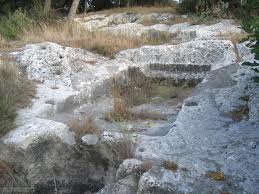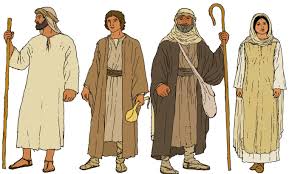In addition to our fields, over many generations we have terraced the sides of the hills, and we grow our grapes there, facing the sun. Many families have used the rocks that they have had to remove to plant the vines, to build a wall around their plot, and sometimes even a little house where they can store tools, or where they can come in the evenings to tend the vines and eat and drink their evening meal. In places families have got together and have hollowed out the rocks into large flat tank with a run off spout. When the grapes are ready they are put in the tank, and then they are trampled to get all the juice out. The juice is then siphoned off into wine skins to store and mature.
Jesus works Joseph’s ancestral lands. As he is also the village carpenter, he has to hire in workers to do much of the routine work. He is known as a generous employer, and the men waiting in the market place, ready to hire themselves out for the day, are always happy to work for him, and work hard for him. Nathan has chastised Jesus on more than one occasion for paying more than other men, but Jesus just says that these labourers have to live and feed their families. Why should he get rich, while these men and their families starve? It went round the town one day that Jesus had paid a whole day’s wages to all of the men he had employed that day, even those who had not started work until the 11th hour. No wonder all of those who began work at daybreak and worked through the heat of the day were really angry. He nearly started a rebellion!
It is important to all of us that we should get the maximum amount of crops off our land. We need them to feed our families. Things would be a lot easier for us were it not for the crippling taxes that we have to pay. First the Roman tax collectors come around and inspect our crops and take a hefty percentage, which varies from year to year, and appears to be at the whim of the tax collector. This is to be sent to Rome to feed the citizens there. Then they add on a bit for themselves. I have never yet seen a thin tax collector. Then the tax collectors from Herod’s Jewish authorities come around and take their cut, and a bit for themselves, and then there is the one shekel, which is about four days wages, that every Jewish adult male has to pay for the upkeep of the Temple. There are some years when the crop is not particularly heavy, when we end up starving or nearly starving because so much of the food we grew to feed ourselves has gone to feed someone else. The tax collectors are less likely to take the fruit and vegetables we grow on the plots of land beside our houses, as they would have to go straight to market and be sold, unless they were for immediate consumption. Of course if it is a bad year, they will look anywhere and everywhere to get the money they want, and if we starve, they just don’t care.
Jesus looked moodily at the plants growing along the edge of his field. “We had such a bad harvest last year that I really needed to get the best crop possible this year. I kept just enough seed to cover my field, and we are really having to ration what we eat until the wheat harvest comes in.” He sat back on his heels. “Well look at the birds. They haven’t ploughed or sown, and still God is feeding them, through me. They won’t starve this year. If I get labourers to pull out the thorns, then these plants at the edges might produce at least some crop, but it is going to cost me. Look at those plants growing over there where the path started to be widened this year, because we found so many stones. The seeds which are in among those stones will just wither in the sun because stone does not hold water. Oh well. I will just have to trust that God will send water and sunshine in enough abundance to feed not only me and mine, but the labourers who will help get this crop in and the birds, the tax collectors, the Sanhedrin and the citizens of Rome as well. What a big responsibility I have on my shoulders! ”




